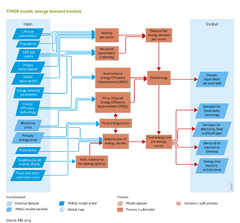Energy demand: Difference between revisions
Jump to navigation
Jump to search
No edit summary |
No edit summary |
||
| Line 1: | Line 1: | ||
{{ComponentTemplate2 | {{ComponentTemplate2 | ||
|ComponentCode=ED | |ComponentCode=ED | ||
|MainComponent=Energy supply and demand | |MainComponent=Energy supply and demand | ||
|FrameworkElementType=model component | |||
|Status=Publishable | |||
|IMAGEComponent=Energy supply and demand; Energy conversion; Energy supply; | |IMAGEComponent=Energy supply and demand; Energy conversion; Energy supply; | ||
|KeyReference=Daioglou et al., 2012; Girod et al., 2012; Van Ruijven et al., 2012; | |KeyReference=Daioglou et al., 2012; Girod et al., 2012; Van Ruijven et al., 2012; | ||
|InputVar=GDP per capita; Value added; Private consumption; Population per Region; Energy intensity parameters; Energy efficiency technology; Exogenous market shares; Primary energy price; Electricity price; Lifestyle parameters; | |InputVar=GDP per capita; Value added; Private consumption; Population per Region; Energy intensity parameters; Energy efficiency technology; Exogenous market shares; Primary energy price; Electricity price; Lifestyle parameters; | ||
|OutputVar=Demand for primary energy; Demand for electricity and hydrogen; Demand for traditional biomass; People dependent on solid fuel; | |||
|Parameter=Taxes and other additional costs; Preferences; | |Parameter=Taxes and other additional costs; Preferences; | ||
|Flowchart=EnergyDemandModel.png | |Flowchart=EnergyDemandModel.png | ||
|CaptionText=Flow diagram of the TIMER energy demand model | |CaptionText=Flow diagram of the TIMER energy demand model | ||
|AltText=Flow diagram of the TIMER energy demand model | |AltText=Flow diagram of the TIMER energy demand model | ||
}} | }} | ||
Revision as of 10:48, 12 November 2013
| Component is implemented in: |
|
| Related IMAGE components |
| Projects/Applications |
| Key publications |
Key policy issues
- How will energy demand evolve particularly in emerging and medium- and low-income economies?
- What is the mix of end-use energy carriers to meet future energy demand?
- How can energy efficiency contribute to reducing the growth rate of energy demand and mitigate pressures on the global environment?
Introduction
"model component" is not in the list (driver component, pressure component, interaction component, state component, impact component, response component) of allowed values for the "FrameworkElementType" property.
